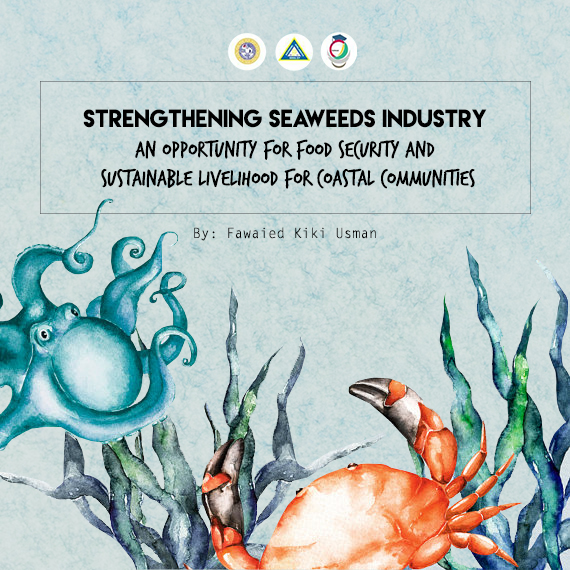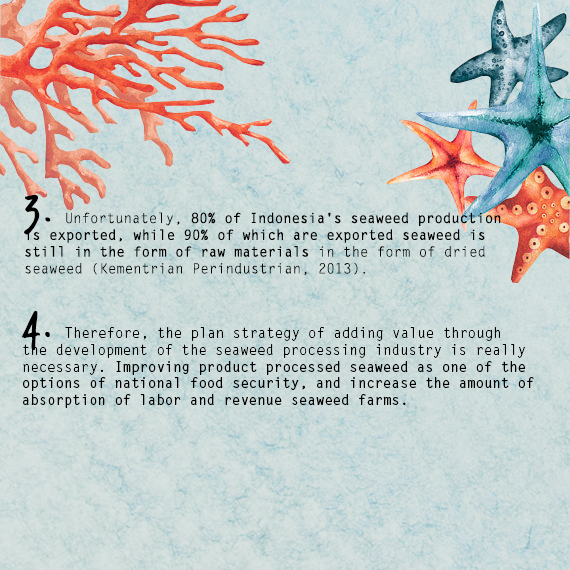Strengthening Seaweeds Industry: An Opportunity for Food Security and Sustainable Livelihood for Coastal Communities
By: Fawaied Kiki Usman
Seaweed is a versatile product that can be used for direct human consumption or processed into food additives, pet food, feeds, fertilizers, biofuel, cosmetics, and medicines (McHugh, 2003; Bixler and Porse, 2011). Due to the enormous benefits, McHugh and Lanier (1983) and Anggadiredja et al. (2006) in Rajagukguk (2009) predict that the use of seaweed will increase in the future with the raising of population and the growth of seaweed-based industries, as well as the tendency of people to consume more of nature products.
According to FAO statistics (FishStat), global production of seaweed increased from less than 4 million wet tonnes2 in 1980 to almost 20 million wet tonnes in 2010 (Figure 1) corresponding with the increase of farmgate value from USD 72 million to USD 1.4 billion. Cultivation of red seaweeds (Rhodophyceae) contributed to most of the recent expansion in global seaweed production. According to FAO statistics, red seaweed farming production worldwide increased from 2 million wet tonnes in 2000 (21 percent of the production of all cultivated seaweeds) to almost 9 million wet tonnes in 2010 (47 percent). Major red seaweed species under cultivation include Kappaphycus and Eucheuma, which are primary raw materials for carrageenan, Gracilaria (primary raw materials for agar), and Nori (mainly fordirect human consumption).
Major carrageenan seaweed farming countries are Indonesia, Philippines, the United Republic of Tanzania, Malaysia and China (Figure 2). According to the figure above, Indonesia is currently the largest carrageenan seaweed farming country, accounted for 61 percent of world production in 2010, overcome the Philippines which was the largest carrageenan seaweed farming country back in the 2000 with 72% of world production due to the rapid expansion of carageenan seaweed farming in Indonesia. Kappaphycus is the main cultivated species in Indonesia.
The residents of coastal communities in Indonesia already using seaweed in their daily life. According to Chen and Duan (2000), seaweed widely used as food for humans and pharmaceuticals (anticoagulant, antibiotics, antimehmetes, antihypertensiveagent, cholesterol reducers, dilatoryagent, and insecticides). Seaweed is also widely used as feed material in marine organisms, as a fertilizer and soil conditioner, which is excellent for lobster and clam life (especially of the type Ascophyllum and Focus), as a stabilizer solution, as well as other uses. The development of derivative products today are also processed into paper, paints, cosmetics, laboratory supplies, toothpaste, ice cream, and many more. (Indriani & Suminarsih, 1999).
Seaweed farming has been generally expanding in Indonesia by 2009, it provided an average annual income of USD 5000 to an estimated 20.000 farm families working on a part-time basis, while the diligent farmers have been able to make income two to three times higher that amount by working full time or by employing the “leader model” approach to farming (McHugh and Lanier, 1983). Such earnings are well above the poverty level. Many farmers generally asserted that seaweed farming was by far their most lucrative economic activity. Seaweed farming has also been complementary and compatible with other village economic activities such as fishing and farming land crops. The outcome from seaweed farming also had a noticeable multiplier effect. Shops, and support services for seaweed farming and village infrastructure have all benefited from seaweed cash flowing through local village economies.
Based on those facts, the seaweed in addition to maintaining food security also could support the economy of coastal communities. Considering almost all coastal communities in Indonesia depend on aquatic resources, especially the cultivation of seaweed, since Indonesia contains tropical waters that are rich in genetic resources of seaweed (Van Bosse 1899-1990). Meanwhile, seaweed cultivation does not require a lot of costs, compared to the fish catching and cultivate it which require more costs, high risk, and time.
Unfortunately, another problem is the amount of seaweed production in Indonesia is not accompanied by the production capacity of processed seaweed. So that nearly 80% of Indonesia's seaweed production is exported. Meanwhile, 90% of which are exported seaweed is still in the form of raw materials in the form of dried seaweed (Kementerian Perindustrian, 2013), and only 20% that can be absorbed and processed by the domestic industry. This leads to the added value produced by seaweed products tend to be minimal. It is really unfortunate, in fact that seaweed is a commodity that can generate added value high enough if it has been through the treatment process (Hikmah, 2015).
Therefore, the plan strategy of adding value through the development of the seaweed processing industry is really necessary. With the industrialization of seaweed activities would increase the diversification of high value-added products, improve product processed seaweed as one of the options of national food security, and increase the amount of absorption of labor and revenue seaweed farms.
This should attract all the stakeholders that is seaweed processing industry would have enormous benefits, not only in the upstream sector but also in the downstream sector. Commodities seaweed has backward and forward linkage. The linkage is based on the use of technology in the processing division. Backward linkages mean that the resulting product is still using simple technology, namely dried seaweed processing into semi-finished materials, and processing of seaweed into a food/ beverage. Then from semi-finished materials is passed on to the industry that can produce auxiliary raw materials such as carrageenan, agar, alginates, and so on. Furthermore, from the auxiliary raw materials used in high-tech industry and recorded more than 500 consumer goods end products that use seaweed as an adjuvant in various scales and levels, such as dairy products industry, pharmaceutical, cosmetics, technology, materials, etc.It is expected that the stakeholders can develop seaweed processing industry in Indonesia, while in business, the seaweed processing industry still has vast market potential since this industry is less in the marketIn terms of local-benefit, increased demand for seaweeds in the country will have a positive impact to the well-being of coastal communities.
References
Anggadiredja, J. T. 2007. Prospek Pasar Rumput Laut Indonesia di Pasar Global. Lokakarya Implementasi Program Berkelanjutan Sulawesi Selatan Menuju Sentra Rumput Laut Dunia. Makalah. Makasar, Diakses pada tanggal 7 April 2017.
Chen, K.Z. & Duan, Y. 2000. Competitiveness of Canadian agri-food exports againts competitors in asia: 1980-971. Journal of International Food & Agribusiness Marketing, 11(4). Diakses pada tanggal 7 April 2017.
FAO. 2005–2010. Cultured aquatic species information programme. Eucheuma spp. Cultured Aquatic Species Information Programme. Text by G.C. Trono Jr. In: FAO Fisheries and Aquaculture Department [online]. Rome. Updated 13 January 2005. [Cited 12 February 2010]. www.fao.org/fishery/culturedspecies/Eucheuma_spp/en. Diakses pada tanggal 9 April 2017.
Hikmah. 2015. Strategy of Commudity Precessing Industry Development E.cottonii Seaweed to Increasing Value Added in The Are Center of industrialization. Balai Besar Kementerian Kelautan dan Perikanan RI. Jakarta. Diakses pada tanggal 4 April 2017.
Indriani, H. & Suminarsih, E. 1999. Budidaya, pengolahan dan pemasaran rumput laut. Penebar Swadaya. Cetakan ke-6. Jakarta. Diakses pada tanggal 4 April 2017.
Kementerian Perindustrian. 2013. Meningkatkan Ekspor Rumput Laut Olahan ke Eropa. Diakses dari website: http://agro.kemenperin. go.id/1846-Meningkatkan-Ekspor-Rum- put-Laut-OlahanKe-Eropa. Diakses pada tanggal 6 April 2017.
McHugh, D.J. 1996. Seaweed production and markets. FAO/GLOBEFISH Research Programme Vol. 48. Rome, FAO. 73 pp. McHugh, D.J. 2002. Prospects for seaweed production in developing countries. FAO Fisheries Technical Circular. No. 968. Rome, FAO. 28 pp. Diakses pada tanggal 8 April 2017.
Rajagukguk, M. M. 2009.Analisis Daya Rumput Laut Indonesia di Pasar Internasional. [Skripsi, Tidak Diterbitkan]. Departemen Agribisnis. Fakultas Ekonomi dan Manajemen. Institut Pertanian Bogor. Bogor. Diakses pada tanggal 8 April 2017.




